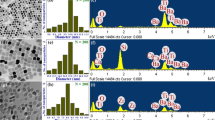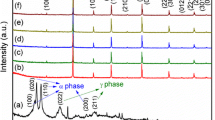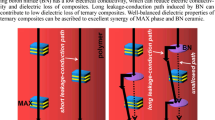Abstract
High-dielectric-constant (high-ε) ceramic/polymer composites are an important class of advanced functional materials due to their applications in energy storage fields, such as embedded capacitors. Here, we synthesized novel polymer-derived silicon carbonitride (SiCN)-filled polyvinylidene fluoride (PVDF) composites by the tape-casting method. For comparison, commercial BaTiO3-filled PVDF composites were synthesized following the same process. The SiCN/PVDF composites showed much higher ε than the BaTiO3/PVDF composites over a broad frequency range (10−1–106 Hz). Furthermore, the SiCN/PVDF composites showed ultrahigh ε at low frequencies. The ε of the 40 vol% SiCN/PVDF composite was as high as 2600 at 10−1 Hz. Although the dielectric breakdown strengths of the SiCN/PVDF composites were slightly lower than those of the BT/PVDF composites, the calculated maximum energy storage density of the 40 vol% SiCN/PVDF composites (17.5 J cm−3) was much higher than that of 40 vol% BT/PVDF (0.773 J cm−3) at 10−1 Hz. This is the first report on the use of polymer-derived ceramics as a component of ceramic/polymer composites. The results indicate that the polymer-derived SiCN ceramics can serve as promising ceramic fillers for high-ε composites and that the obtained SiCN-filled composites have promising applications in energy storage fields.






Similar content being viewed by others
References
Dang Z-M, Yuan J-K, Yao S-H, Liao R-J (2013) Flexible nanodielectric materials with high permittivity for power energy storage. Adv Mater 25:6334–6365. https://doi.org/10.1002/adma.201301752
Chu B, Zhou X, Ren K et al (2006) A dielectric polymer with high electric energy density and fast discharge speed. Science 313:334–336. https://doi.org/10.1126/science.1127798
Dang Z-M, Wang H-Y, Peng B, Nan C-W (2008) Effect of BaTiO3 size on dielectric property of BaTiO3/PVDF composites. J Electroceram 21:381–384. https://doi.org/10.1007/s10832-007-9201-8
Xu R, Tian J, Zhu Q et al (2017) Effects of La-induced phase transition on energy storage and discharge properties of PLZST ferroelectric/antiferroelectric ceramics. Ceram Int 43:13918–13923. https://doi.org/10.1016/j.ceramint.2017.07.120
Tarale AN, Premkumar S, Reddy VR, Mathe VL (2017) Microstructural evolution of 0.75PMN–0.25PT ferroelectrics synthesized by hydroxide co-precipitation method and their dielectric properties. J Mater Sci Mater Electron 28:5485–5497. https://doi.org/10.1007/s10854-016-6210-x
Yoo J, Kim Y, Cho H, Jeong Y-H (2017) High piezoelectric d 31 coefficient and high T c in PMW-PNN-PZT ceramics sintered at low temperature. Sens Actuat Phys 255:160–165. https://doi.org/10.1016/j.sna.2016.12.020
Tang H, Lin Y, Andrews C, Sodano HA (2011) Nanocomposites with increased energy density through high aspect ratio PZT nanowires. Nanotechnology 22:015702-1–015702-8. https://doi.org/10.1088/0957-4484/22/1/015702
Wang M, Li WL, Feng Y et al (2015) Effect of BaTiO3 nanowires on dielectric properties and energy storage density of polyimide composite films. Ceram Int 41:13582–13588. https://doi.org/10.1016/j.ceramint.2015.07.153
Jayakrishnan P, Ramesan MT (2018) Temperature dependence of the electrical conductivity of poly(anthranilic acid)/magnetite nanocomposites and the applicability of different conductivity models. Polym Compos 39:2791–2800. https://doi.org/10.1002/pc.24271
Ramesan MT, Jayakrishnan P, Manojkumar TK, Mathew G (2018) Structural, mechanical and electrical properties biopolymer blend nanocomposites derived from poly (vinyl alcohol)/cashew gum/magnetite. Mater Res Express 5:015308. https://doi.org/10.1088/2053-1591/aaa25f
Yang Y, Zhu B-P, Lu Z-H et al (2013) Polyimide/nanosized CaCu3Ti4O12 functional hybrid films with high dielectric permittivity. Appl Phys Lett 102:042904-1–042904-5. https://doi.org/10.1063/1.4789504
Dang Z-M, Zhou T, Yao S-H et al (2009) Advanced calcium copper titanate/polyimide functional hybrid films with high dielectric permittivity. Adv Mater 21:2077–2082. https://doi.org/10.1002/adma.200803427
Bhandavat R, Kuhn W, Mansfield E et al (2012) Synthesis of polymer-derived ceramic Si(B)CN-carbon nanotube composite by microwave-induced interfacial polarization. ACS Appl Mater Interfaces 4:11–16. https://doi.org/10.1021/am201358s
Lu B, Zhang Y (2014) Hot pressed SiC ceramics employing polymer-derived SiBCN as sintering aid. Mater Lett 137:483–486. https://doi.org/10.1016/j.matlet.2014.09.074
Colombo P, Mera G, Riedel R, Sorarù GD (2010) Polymer-derived ceramics: 40 years of research and innovation in advanced ceramics: polymer-derived ceramics. J Am Ceram Soc 93:1805–1837. https://doi.org/10.1111/j.1551-2916.2010.03876.x
Wang K, Ma B, Wang Y, An L (2013) Complex impedance spectra of polymer-derived silicon oxycarbides. J Am Ceram Soc 96:1363–1365. https://doi.org/10.1111/jace.12356
Wang K, Ma B, Li X et al (2014) Effect of pyrolysis temperature on the structure and conduction of polymer-derived SiC. J Am Ceram Soc 97:2135–2138. https://doi.org/10.1111/jace.12931
Ma B, Wang Y, Wang K et al (2015) Frequency-dependent conductive behavior of polymer-derived amorphous silicon carbonitride. Acta Mater 89:215–224. https://doi.org/10.1016/j.actamat.2015.02.020
Su D, Li Y-L, Feng Y, Jin J (2009) Electrochemical properties of polymer-derived SiCN materials as the anode in lithium ion batteries. J Am Ceram Soc 92:2962–2968. https://doi.org/10.1111/j.1551-2916.2009.03317.x
Pradeep VS, Ayana DG, Graczyk-Zajac M et al (2015) High rate capability of SiOC ceramic aerogels with tailored porosity as anode materials for Li-ion batteries. Electrochim Acta 157:41–45. https://doi.org/10.1016/j.electacta.2015.01.088
Huo X, Li W, Zhu J et al (2015) Composite based on Fe3O4 @BaTiO3 particles and polyvinylidene fluoride with excellent dielectric properties and high energy density. J Phys Chem C 119:25786–25791. https://doi.org/10.1021/acs.jpcc.5b08809
Facchetti A, Yoon M-H, Marks TJ (2005) Gate dielectrics for organic field-effect transistors: new opportunities for organic electronics. Adv Mater 17:1705–1725. https://doi.org/10.1002/adma.200500517
Jiongxin Lu, Wong C (2008) Recent advances in high-k nanocomposite materials for embedded capacitor applications. IEEE Trans Dielectr Electr Insul 15:1322–1328. https://doi.org/10.1109/TDEI.2008.4656240
Yue Z, Zhao J, Yang G, Li L (2010) Electric field-dependent properties of BaTiO3-based multilayer ceramic capacitors. Ferroelectrics 401:56–60. https://doi.org/10.1080/00150191003670424
Ning N, Ma Q, Liu S et al (2015) Tailoring dielectric and actuated properties of elastomer composites by bioinspired poly(dopamine) encapsulated graphene oxide. ACS Appl Mater Interfaces 7:10755–10762. https://doi.org/10.1021/acsami.5b00808
Maiti S, Shrivastava NK, Khatua BB (2013) Reduction of percolation threshold through double percolation in melt-blended polycarbonate/acrylonitrile butadiene styrene/multiwall carbon nanotubes elastomer nanocomposites. Polym Compos 34:570–579. https://doi.org/10.1002/pc.22462
Kleebe H-J, Störmer H, Trassl S, Ziegler G (2001) Thermal stability of SiCN ceramics studied by spectroscopy and electron microscopy: thermal stability of SiCN ceramics. Appl Organomet Chem 15:858–866. https://doi.org/10.1002/aoc.243
Li Q, Yin X, Feng L (2012) Dielectric properties of Si3N4–SiCN composite ceramics in X-band. Ceram Int 38:6015–6020. https://doi.org/10.1016/j.ceramint.2012.03.045
Liu S, Xue S, Zhang W et al (2014) Significantly enhanced dielectric property in PVDF nanocomposites flexible films through a small loading of surface-hydroxylated Ba0.6Sr0.4TiO3 nanotubes. J Mater Chem A 2:18040–18046. https://doi.org/10.1039/C4TA04051A
Dang Z-M, Wang H-Y, Zhang Y-H, Qi J-Q (2005) Morphology and dielectric property of homogenous BaTiO3/PVDF nanocomposites prepared via the natural adsorption action of nanosized BaTiO3. Macromol Rapid Commun 26:1185–1189. https://doi.org/10.1002/marc.200500137
Song Y, Shen Y, Liu H et al (2012) Improving the dielectric constants and breakdown strength of polymer composites: effects of the shape of the BaTiO3 nanoinclusions, surface modification and polymer matrix. J Mater Chem 22:16491–16498. https://doi.org/10.1039/c2jm32579a
Zhou T, Zha J-W, Cui R-Y et al (2011) Improving dielectric properties of BaTiO3/ferroelectric polymer composites by employing surface hydroxylated BaTiO3 nanoparticles. ACS Appl Mater Interfaces 3:2184–2188. https://doi.org/10.1021/am200492q
Ehrhardt C, Fettkenhauer C, Glenneberg J et al (2014) Enhanced dielectric properties of sol–gel–BaTiO3/P(VDF-HFP) composite films without surface functionalization. RSC Adv 4:40321–40329. https://doi.org/10.1039/C4RA03715D
Li X, Chen F, Wang Y (2017) Colossal dielectric constant and interfacial charge polarization in a polymer-derived amorphous silicon carbonitride. Ceram Int 43:11623–11626. https://doi.org/10.1016/j.ceramint.2017.05.337
Ma B, Wang Y, Chen Y, Gao Y (2017) Dielectric property and interfacial polarization of polymer-derived amorphous silicon carbonitride. Ceram Int 43:12209–12212. https://doi.org/10.1016/j.ceramint.2017.06.081
Jasna VC, Ramesan MT (2018) Fabrication of novel nanocomposites from styrene-butadiene rubber/zinc sulphide nanoparticles. J Mater Sci 53:8250–8262. https://doi.org/10.1007/s10853-018-2173-z
Xu N, Hu L, Zhang Q et al (2015) Significantly enhanced dielectric performance of poly(vinylidene fluoride-co-hexafluoropylene)-based composites filled with hierarchical flower-like TiO2 particles. ACS Appl Mater Interfaces 7:27373–27381. https://doi.org/10.1021/acsami.5b08987
Kim P, Doss NM, Tillotson JP et al (2009) High energy density nanocomposites based on surface-modified BaTiO3 and a ferroelectric polymer. ACS Nano 3:2581–2592. https://doi.org/10.1021/nn9006412
Hou Y, Deng Y, Wang Y, Gao H (2015) Uniform distribution of low content BaTiO3 nanoparticles in poly(vinylidene fluoride) nanocomposite: toward high dielectric breakdown strength and energy storage density. RSC Adv 5:72090–72098. https://doi.org/10.1039/C5RA10438F
Dang Z-M, Yuan J-K, Zha J-W et al (2012) Fundamentals, processes and applications of high-permittivity polymer-matrix composites. Prog Mater Sci 57:660–723. https://doi.org/10.1016/j.pmatsci.2011.08.001
Acknowledgements
This work was financially supported by the National Natural Science Foundation of China (Grant Nos. 51372202, #51602264, #51532003, and #51732009) and the Science and Technology Project in Sichuan Province (2016JY0112).
Author information
Authors and Affiliations
Corresponding authors
Rights and permissions
About this article
Cite this article
Sun, D., Chen, F., Gao, Y. et al. Polymer-derived SiCN ceramics as fillers for polymer composites with high dielectric constants. J Mater Sci 54, 6982–6990 (2019). https://doi.org/10.1007/s10853-018-03299-2
Received:
Accepted:
Published:
Issue Date:
DOI: https://doi.org/10.1007/s10853-018-03299-2




